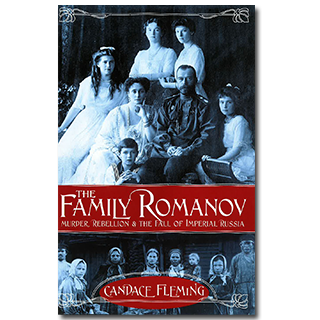
A FEW OTHER EVENTS FOR
NOVEMBER 10:
- Best birthday wishes to Neil Gaiman (The Graveyard Book).
- Happy birthday to the United States Marine Corps, first formed on this day in 1775. Read The Journal of Patrick Seamus Flaherty by Ellen White.
- Can you hear me now? Direct-dial coast-to-coast telephone service begins in the United States in 1951. Read Telephone by Kornei Chukovsky.
- In 1958, the allegedly cursed Hope Diamond is donated to the Smithsonian National Museum of Natural History in Washington, D.C. Read The Robbery at the Diamond Dog Diner by Eileen Christelow.
- Happy birthday Sesame Street. The television show debuted in 1969.
On November 7, 1917, a revolution began in Russia that would change the twentieth century. In what is sometimes called the October Revolution, Bolshevik Revolution, or the October Uprising (because at the time Russia used the Julian or Old Style calendar), Bolshevik Red Guards began to seize buildings in Moscow, Saint Petersburg, and the Winter Palace.
It was not until I was in college that I began to understand the events of 1917. Hence, I was thrilled to read Candace Fleming’s new book, The Family Romanov: Murder, Rebellion & The Fall of Imperial Russia, which adeptly lays out the scope of these turbulent times for readers ages eleven through sixteen. She draws her audience into these events by focusing on arguably the most sympathetic figures of the time–from an American point of view—the Romanov family: the Emperor and Empress of Russia, and their children.
Nicholas and Alexandra, the world’s wealthiest monarchs, ruled more than one-sixth of the land’s surface of the earth. Fleming deftly introduces readers to the family and the tragedy surrounding the only son, Prince Alexei, who suffered from hemophilia. She brings to life the young and sheltered princesses, Olga, Tatiana, Maria, and Anastasia, who along with their family become more and more isolated from the grim conditions of the Russian peasants. And although Fleming creates a sympathetic portrait of individual members of the family, she does not turn a blind eye to the reasons the revolution occurred. In the end, readers feel much like those soldiers who guarded the Romanovs in the days before their brutal murders; they have grown to love and care for them as human beings.
Candace Fleming has tackled big subjects before in Amelia Lost and The Lincolns. But explaining the Russian Revolution to children and young adults has to be her most audacious undertaking to date. She succeeds brilliantly; readers who do not know anything about this period will be able to proceed comfortably through the narrative. At various spots in the book she has included eye-witness accounts, fabulous primary source material that enriches the story being told. Although Fleming covers the rumors of Anastasia’s survival, she presents the recent discovery of her grave as a counterpoint. A section of photographs in the center of the book adds to its appeal.
So if you are hunting for a book that will help young readers understand world history, or if you just want a piece of narrative nonfiction beautifully told, pick up The Family Romanov. It’s a remarkable feat of nonfiction for young readers that is well executed and compelling. I hope Fleming’s incredible achievement attracts many readers, has a long life, and gains praise and recognition.
Here’s an excerpt from The Family Romanov:
On a frosty March day in 1881, the boy who would become Russia’s last ruler glimpsed his future. That morning, Nicholas’s grandfather, Tsar Alexander II, was riding through the streets of St. Petersburg when a man stepped off the sidewalk. He hurled a bomb at the imperial carriage. Miraculously, the tsar was uninjured, but many in his retinue were not as lucky. Concerned about his people, Alexander stepped from his carriage. That’s when a second bomb was thrown. This one landed between his feet. An explosion of fire and shrapnel tore away Alexander’s left leg, ripped open his abdomen, and mangled his face. Barely conscious, he managed one last command: “to the palace, to die there.”
Originally posted November 10, 2014. Updated for .













Hey there! I just finished this book yesterday and thoroughly enjoyed it! Thank you so much for your wonderful website and keep up the great work! I look forward to it every morning.
I can’t wait to read this. My students and teachers will just eat this up!